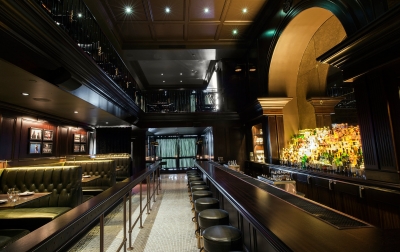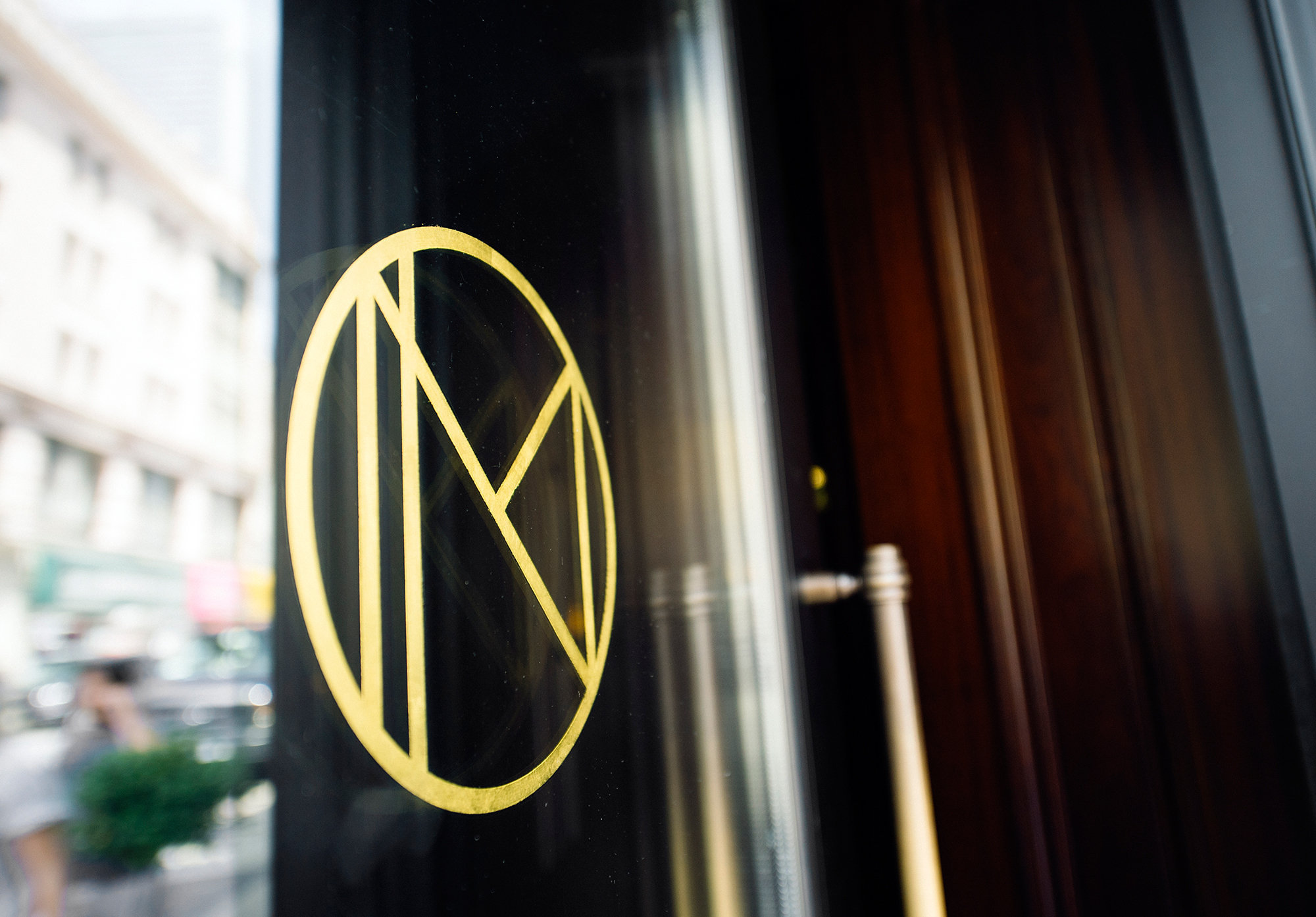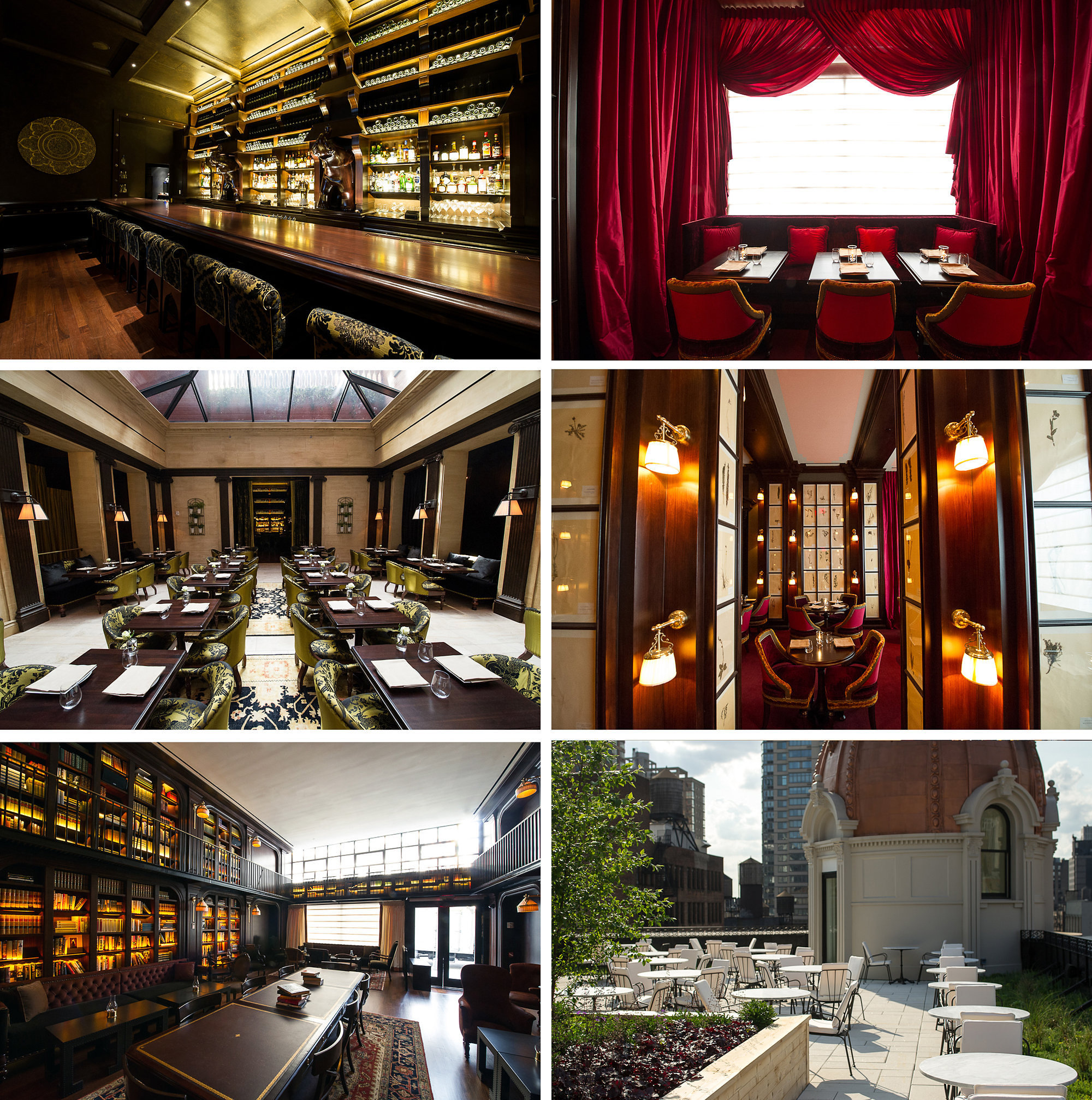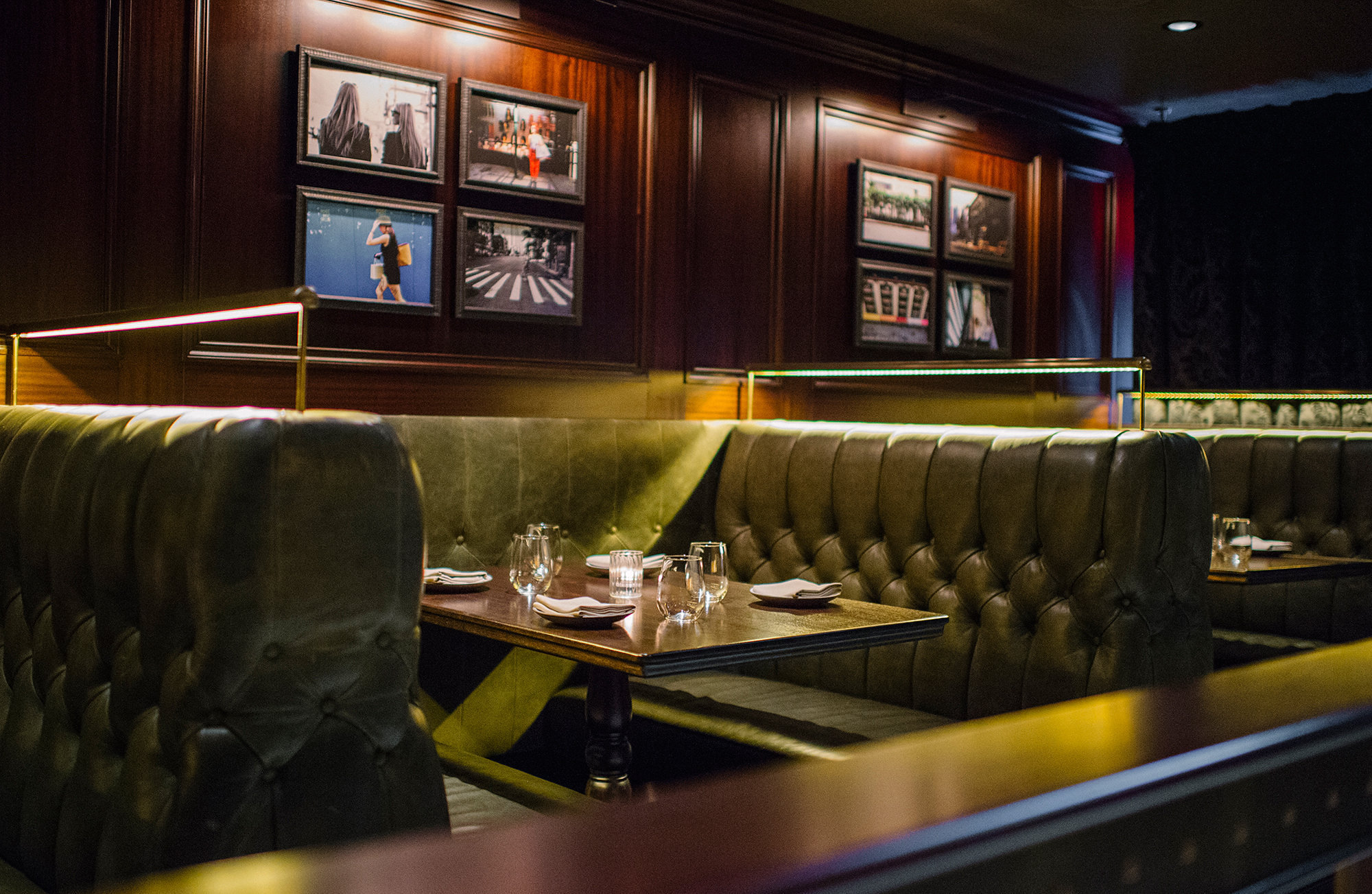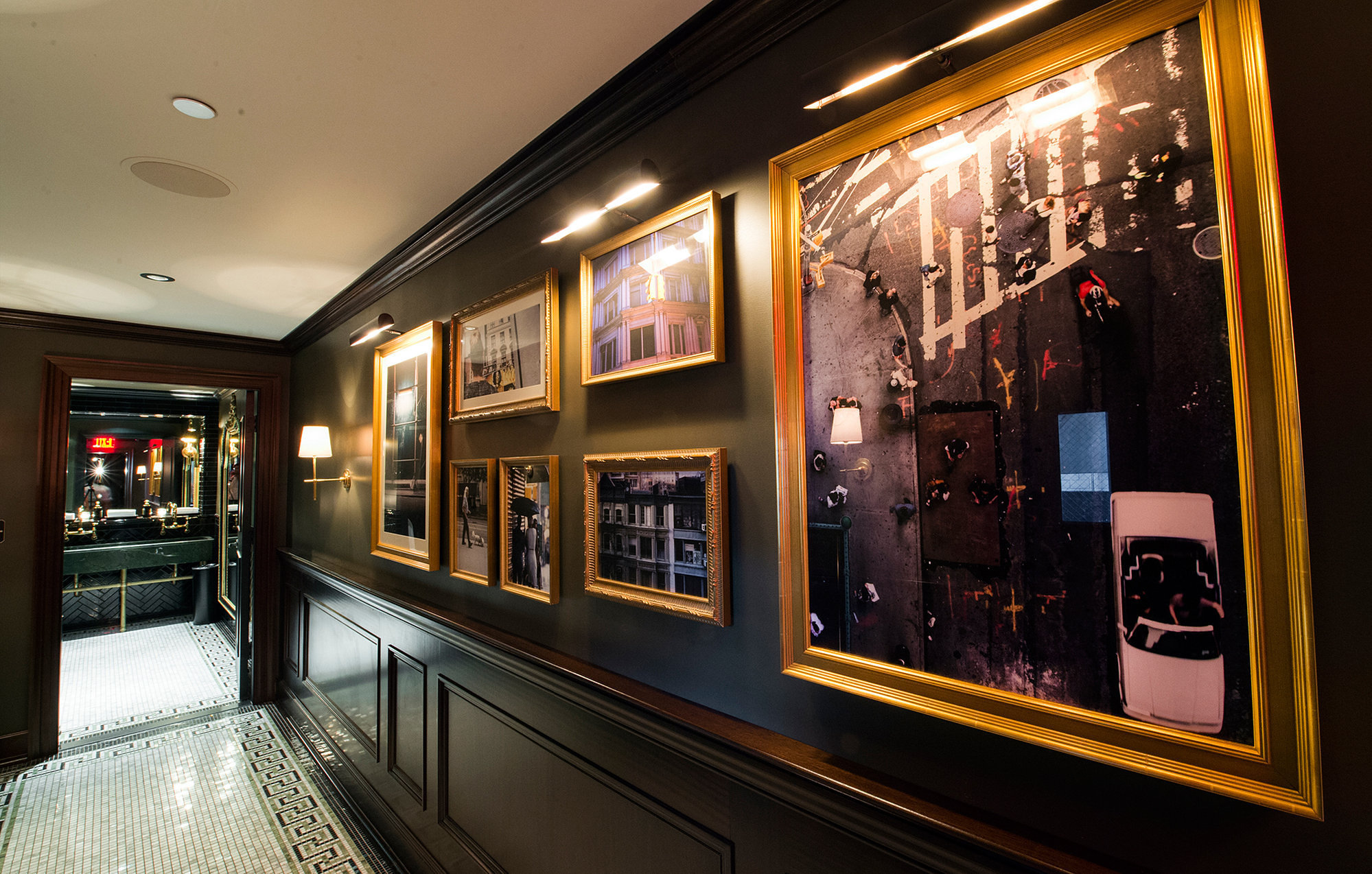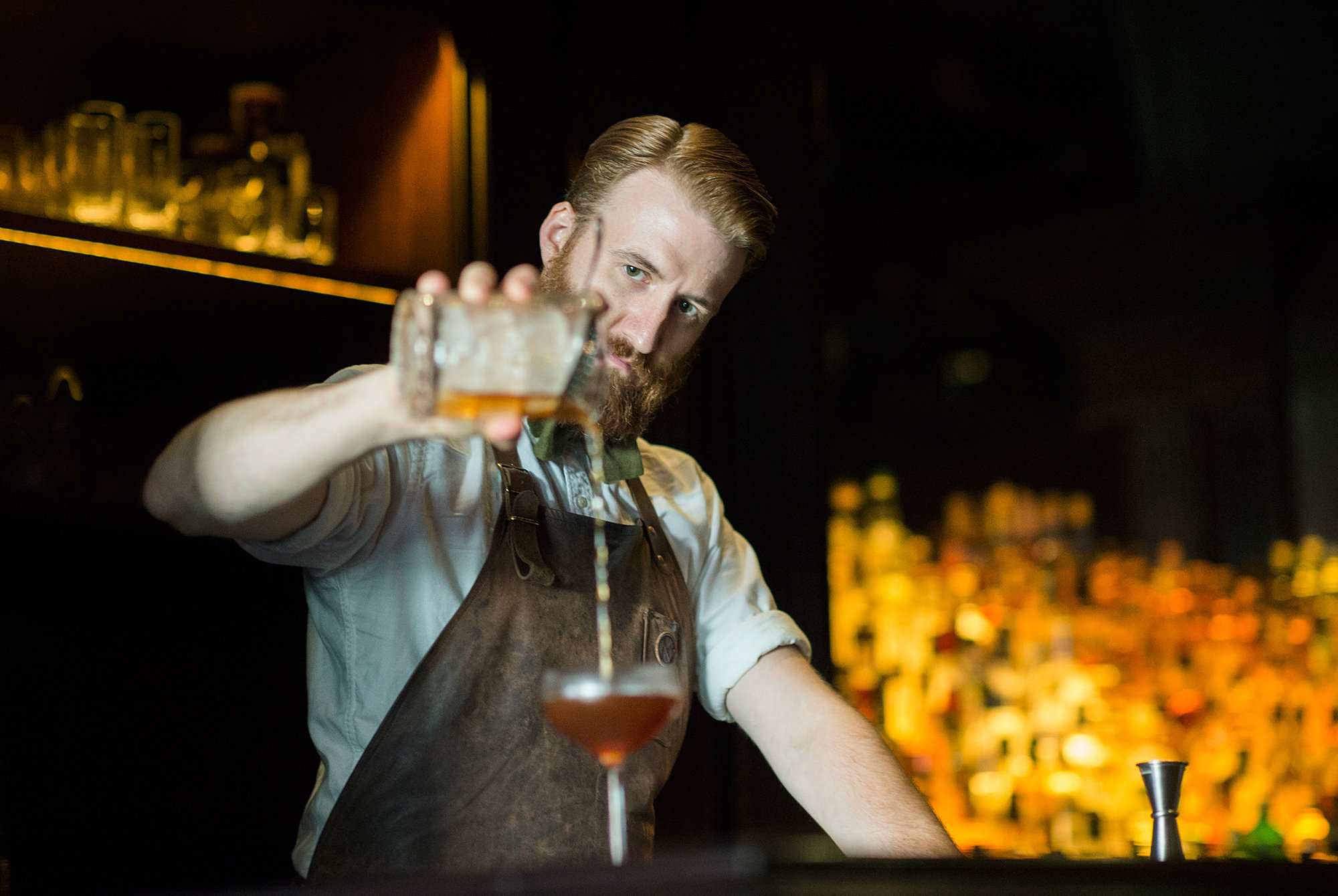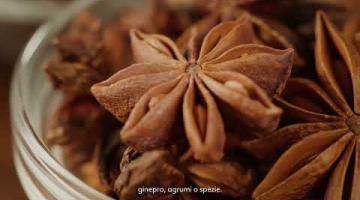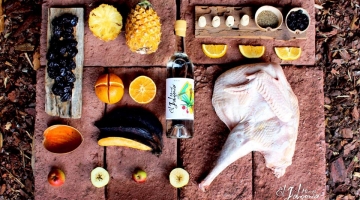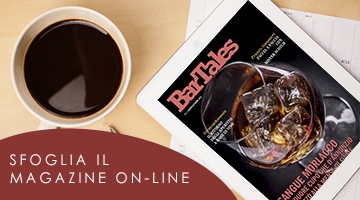About six months into operating food and beverage for The NoMad Hotel on Broadway at 28th Street in Manhattan, partners Will Guidara and chef Daniel Humm realized they had a problem. The team had encountered two major flaws with division of space related to the property's namesake restaurant, which includes the attached bar The Elephant Bar, an annexed drinking room simply dubbed the Library, and a rooftop private dining room. Guidara explains: "One was that for the hotel guests ... there was nowhere for them to just relax. We're trying to make this a home away from home and they had nowhere to relax because the Library was always full. And the second flaw was that the bar was too small and so many people were trying to come ... we were just saying no to people all the time and we got in this business to say yes."
About a year and a half ago, Guidara and Humm began to consider taking over two adjacent empty spaces around the corner from the hotel on 28th Street between Broadway and Fifth Avenue: one formerly a cell phone cover store and the other a computer repair shop. They contemplated merging the two into a bar. In addition to providing hotel guests and non-hotel guests with an extra place to kick back, thereby freeing up room in the Library and The Elephant Bar, the proposed new NoMad Bar would also present Guidara and Humm with another venue to extend The NoMad brand in an equally refined but more casual setting.
Simply put, The NoMad Bar is a pub-inspired, relaxed rendition of its sister restaurant next door. The same key players are involved — Guidara, Humm, plus hotel developer the Sydell Group — so it's no surprise that the level of finesse which goes into running The NoMad is applied at the bar, minus a few formalities. One can order excellent cocktails by Eleven Madison Park/The NoMad Bar Director Leo Robitschek, plus tartares and black truffle foie gras chicken pot pie by The NoMad's executive chef James Kent.
And just for the record, The Elephant Bar used to be called "The NoMad Bar," but Guidara and Humm renamed it for the sake of distinction. They've also since changed over the drinking policy in the Library: it's open to the public during the day, but at night it's reserved for hotel guests only.
The NoMad Hotel
In 2008, the Sydell Group acquired an office building on Broadway at 28th Street with the intent to rework the property into "a classic hotel in the European tradition but infused with a modern sensibility," according to Sydell Group CEO Andrew Zobler. He approached Guidara and Humm about the project, and they immediately jumped at the opportunity because of the property's close proximity to their first restaurant, Eleven Madison Park, and because they had longed to open a complementary place with a less buttoned-up environment.
Following in the footsteps of Eleven Madison Park, with its grand dining room and menu that incorporates New York's "centuries-old culinary traditions," Guidara and Humm wanted The NoMad to be an equally stunning property. Also, they wanted it to pay homage to the history of New York and contribute to the restoration of its neighborhood. NoMad — which stands for "North of Madison Square Park" — spans roughly from about 25th to 30th Street and between Lexington and Sixth Avenue in the middle of Manhattan. Around the mid- to late-twentieth century the area started to decline with wholesale merchants moving in, which brings us to NoMad today and Guidara's aspirations to revitalize the once tony neighborhood.
The Vision
Much like The NoMad Hotel, The NoMad Bar's upscale pub aesthetic was a group effort between Guidara, Humm, Zobler, and NY-based architects Stonehill & Taylor (Diamond Horseshoe, NY; Prairie Restaurant & Marketplace, Minneapolis). Zobler explains, "I worked very closely on the design with Will and Daniel and the team at Stonehill Taylor. It was pretty easy as we all shared the same vision for the space in that we all wanted it to feel first and foremost as a natural extension of the hotel." Per Guidara, he and the team all enjoy going to pubs, and it's the casual ease and approachability of a typical neighborhood pub that inspired them to open one of their own. Albeit one with a 25-foot mahogany bar and a sommelier on the floor nightly. And although Guidara recognizes that his bar is atypical for a pub, it is accessible and gives New Yorkers an informal enough place to gather.O'Reilly's, a classic divey neighborhood pub on 31st Street between Broadway and 6th Avenue, served as the team's muse.
High vs. Low
The contrast between high and low — of a gentrifying neighborhood surrounded by seedier quarters, slammed with a fancy new hotel and expensive stores like edgy French clothing brand Maison Kitsuné and hip French perfumery Le Labo — is visualized in a series of 29 untitled photos bedecking The NoMad Bar's walls. Guidara hired New York photographer and friend Mackenzie Rollins to memorialize the NoMad zone through her photography. And not only do her images — candid street photos taken over a period of eight weeks from 26th to 30th Street and from 5th to 7th Avenue — depict the range of pedestrians, from models to drug dealers, but the decision to juxtapose street photography in a space lush with mahogany, leather, and rich tones further demonstrates the theme of luxury and grit.
One central image hanging above The NoMad's antique marble fireplace on the first floor is a shot of a woman in what one can presume is a couture gown and heels. She walks across a gritty gum-studded sidewalk; the gum speaking to the age of the dirty street. Rollins notes that she would often hang over the side of the hotel and watch the patterns of people below. She noticed that on The NoMad Hotel side, the pavement is completely clean, but everywhere else, just across the street, the sidewalk is dirty and speckled with gum. In the most obvious sense, the photo contrasts high versus low, a new generation of wealth moving into a previously run-down neighborhood.
An Army of Artisans
Staying true to the act of honoring its community, The NoMad crew gives a new definition to the word "locavore," a term generally referencing locally-sourced food. Not only are all the craftsmen they find to fire serving trays and blow glass used consistently throughout the company from one project to the next, but that same family of artisans is also local. Candle votive and carafes are crafted by William Couig, the Brooklyn-based glass blower behind furtherdesign, meanwhile metalwork, inclusive of service trays and wine buckets, is by Brooklyn-based Aleksey Kravchuk of Works Manufacturing. He's also contributed metalwork to New York restaurants like Estela, Smith & Mills, and Maison Premiere.
Atop service trays sit leather mats crafted by Ghurka, the NY-based company known for its pricey leather luggage. Guidara's friend from high school, dinnerware designer Jono Pandolfi throws all the plates, bowls, coffee and tea sets for Eleven Madison Park, The NoMad, and now The NoMad Bar at his third floor studio in Union City, New Jersey. Pandolfi estimates that in 2014 he will produce 15,000 to 20,000 pieces of pottery, some of which will end up at other notable restaurants like Gramercy Tavern in New York, Tosca in San Francisco, and Jeffrey's in Austin.
Every Made Nice restaurant (that's the name of Guidara and Humm's hospitality group) sets its tables the same way: a plate with a napkin folded into a square on top plus a water glass. Plates vary in sizes based on the establishment. For example, The NoMad Bar sets share plates down because all the food there is meant to be communal. Reinforcing the theme of casual but proper service, waiters bring diners a rectangular wooden box stacked with knives and forks. Guidara explains the move, "It's our way of making sure that in a super casual environment you have all the silverware you need without us having to get into your space and add the formality of that level of service." Robert Lafferty of Blackpoint Woodworking in Middletown, New Jersey fashioned the silverware boxes and he also crafts the wooden serving boards upon which many dishes are presented.
Though The NoMad Bar team seeks to use local craftsman when possible, wares that require expensive equipment to produce — like silverware and wine glasses — are outsourced. Utensils are designed by French kitchenware maker Guy Degrenne and cotton napkins are by Masa in Italy. Most wine glasses are Riedel, but there's also bar glasses from Cocktail Kingdom located just a couple blocks away.
Robitschek was working on having Old World etched punch bowls made, but he ended up finding exactly what he was looking for from Classic Hostess. Reserve cocktails, which call for old/rare spirits andcost up to $198 each, are served in vintage glasses kept at the ready in a custom cabinet from Koenig Collection based out of Houston, Texas. Robitschek also found those 20-some odd vintage bar glasses thanks to a late night eBay addiction.
And funny enough, with regard to silverware, while most restaurants polish their silver, The NoMad Bar intentionally scruffs its utensils. The team explains that their pieces are brushed silver, but through service the utensils become too shiny on their own. So they have to hand-buff and scratch forks and knives to remove the sheen.
What to Wear
Servers don a vest, white button-up shirt and black jeans designed byKimmie Kakes, a popular uniform crafter responsible for looks at a plethora of restaurants from Marea in New York to Scarpetta in Las Vegas. However, those behind the bar rock badass black leather aprons fashioned by Weft & Warp/Intervale Leatherworks in Maine and bow ties by New York designer Alexander Olch. The thought behind the bar's fashion approach is to carry over a hint of The NoMad formality but in a less fussy way to match what they are trying to accomplish with the general nature of the bar.
A High Class Pub
The NoMad Bar is divided between two floors with 40 seats each and 12 stools at the bar. Each level expresses a different environment. Upstairs one will find Persian rugs and two top tables at regular height for a slightly more intimate experience, meanwhile the ground floor is equipped with that 25-foot mahogany bar presided over by "Bruce," a zeus-like plaster cast head that's also the bar's mascot. There's also comfy oversized olive green leather booths, perched tables, and plenty of standing room. Note the drinking rail in the front room, which juts out into circular areas creating little gathering places. The guys noticed that design at an Irish pub and decided to incorporate the idea. "So many of the design elements at an Irish pub are created for no other reason than to establish community and bring people together ... functionality with an emotional intention ... people are here to connect" states Guidara. GM Jeff Tascarella sums it up as "date night upstairs, party downstairs."
Marble and mohair are anything but common pub materials, and it was Zobler's vision before anyone else to create an aesthetic both at The NoMad Hotel and The NoMad Bar which was directly in contrast to the minimal, sparse restaurant designs now found ubiquitously throughout the city. Explains Zobler, "Our idea was to stick with a timeless classic design but infuse it with some fun. We wanted something that would grow better with age and not be just of the moment." Guidara adds, "New York had moved away from mahogony and fabrics and textures and so that's what we embrace ... the fabrics here are a continuation of the ones throughout." Originally, at the hotel next-door, they hired reputed French architect and interior designer Jacques Garcia (Hôtel Costes) to bring their vision to life. And while Garcia did not contribute to the bar, they did carry on his initial vision with help from Stonehill & Taylor.
The ground floor of The NoMad Hotel was modeled after a house. There's a fireplace in foyer, an atrium, a parlor (the dining room), a library, and a bar that is supposed to represent a wine cellar. The NoMad Bar was meant to be the den, which is why it's darker. Also, connecting back to the hotel, the mosaic tile floor in the lobby is the same as the floor at the bar, but with a different color scheme. The team loved the style, which evokes the period in which the building was built, 1902.
Aside from the vintage fireplace, most furniture and fixtures are new. Wall sconces are by Costantini Design, while tables hail from Table Topics. The bar's larger chairs are by Interna and the smaller armless seats are from Affiliated. Barstools are Delta.
French design firm be-poles is responsible for The NoMad's logo which carries on from the restaurant to the bar.
The NoMad Bar's Surprise Debut
Guidara and Humm continue their neighborhood restoration efforts with The NoMad Bar. And lucky for the team, the path to inception was smooth along the way. Most of the bar's structural changes took place downstairs in the kitchen. After months of anticipation, out of the blue, on June 14, Guidara and Humm, along with the help of friend Brian Canlis (of the iconic Seattle restaurant Canlis), threw open the bar's doors, without a big splashy announcement.
"Restaurants are hard... You have one chance to introduce it to the world." — Will Guidara
Why open all of a sudden with no warning? "Restaurants are hard," states Guidara. "Your first days are the days when you're figuring things out. And they're also the days you're the most harshly critiqued. To give yourself the gift of ... a few days to identify what is working and what is not working ... You want the first impression to be as good as possible ... You have one chance to introduce it to the world. The worst fear is that they're going to see you in the way you didn't want to be seen."
Perhaps a testament to the strength of the team's vision, not much has changed aesthetically at The NoMad Bar since June 14. The drinking rail that runs parallel to the bar was added in order to provide imbibers with leaning real estate and a place to drop drinks, but also to separate the crowd of drinkers from bumping into servers running food. Because, after all, this is a family. And management looks out for employees as much as it does customers. Per Guidara, "It came out much in the way we had hoped."
thanks to original post http://eater.com/archives/2014/08/04/nomad-bar-new-york-city-restaurant-...

